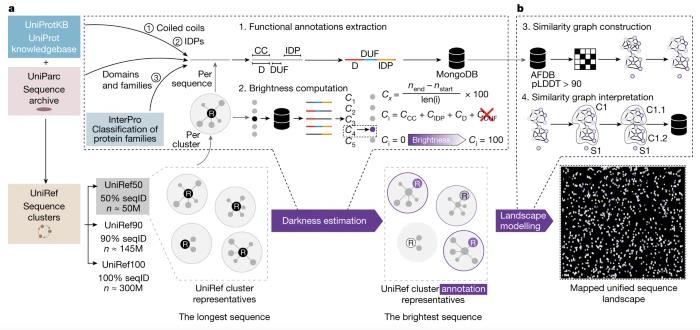In a new study, researchers from the Swiss Institute of Bioinformatics and the University of Basel have discovered a treasure trove of uncharacterized proteins. In the recent deep learning revolution, they have discovered hundreds of new protein families and even a new predictive protein fold. The relevant research results were published online in the journal Nature, with the title “Uncovering new families and folds in the natural protein universe”.
In the past few years, AlphaFold has brought revolutionary changes to protein science. This artificial intelligence (AI) tool is trained based on protein data collected by life scientists for over 50 years and can accurately predict the three-dimensional shape of proteins. Its success led to an astonishing modeling of 215 million proteins last year, providing new insights into the shape of almost all proteins. This is particularly interesting for proteins that have not yet been experimentally studied, as experimental research is a complex and time-consuming process.
The co-author of the paper, Joana Pereira, said, “There are many sources of protein information nowadays, including valuable insights into how proteins evolve and function. However, research has long faced the problem of a data jungle.” Another co-author of the paper is Professor Torsten Schwede.

Revealing new protein families and folds
These authors constructed an interaction network consisting of 53 million proteins with high-quality AlphaFold structures. Dr. Janani Durairaj, the first author of the paper, said, “This network is a valuable source for theoretically large-scale prediction of unknown protein families and their functions.” They discovered 290 new protein families and a new protein fold resembling a flower shape.
Based on Schwede and his research team’s expertise in developing and maintaining leading software SWISS-MODEL, they provide this interaction network as an interactive network resource called the “Protein Universe Atlas”.
Artificial intelligence is an important tool for research
These authors used deep learning-based tools to discover the novelty in this interaction network, paving the way for innovation in life sciences from basic research to applied research. Pereira said, “Understanding the structure and function of proteins is usually the first step in developing new drugs or altering their function through protein engineering.”
With this Protein Universe Atlas, scientists can now gain a better understanding of the proteins related to their research. Durairaj said, “We hope this resource can not only help scientists, but also students and teachers, providing them with a new platform to understand protein diversity (from structure, and function to evolution).”
Featured Products
Protein Pre-coupled Magnetic Beads
Related Services
Protein Expression and Purification Services
Cytokine and Receptor Analysis
Reference
Janani Durairaj et al. Uncovering new families and folds in the natural protein universe. Nature, 2023, doi:10.1038/s41586-023-06622-3.